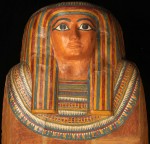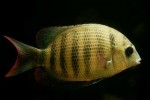Playing a central and important role as the keeper of Bolton’s history, the town’s museum has been part of Boltonians leisure time and education for over 120 years. Originally founded in 1852 it was not long before the growing collection needed more space and work started on Le Mans Crescent which, after war interrupted development, finally opened to the public in October 1947 and is still home to town’s museum and library services today. For visitors who enter the Grade II listed building the same grand sweeping staircases takes them up to the museum where they can leisurely browse the history and mystery which makes this industrial town what it is today.
Bolton Museum boasts a large and significant collection of Egyptian artefacts, many of which were gifted by former local resident Annie Barlow who was the daughter of a mill owner and the Honorary Local Secretary of Bolton Region for the Egypt Exploration Fund (later the Egypt Exploration Society) from whose excavations a large proportion of the museum’s collection derives. The Egyptian collection was only moved to Le Mans Crescent in the 1950s but the current displays have changed very little since their installation and despite the fascinating objects on display, you can’t help feeling that you have stepped back in time.
To help create a space where Bolton’s vast and diverse Egyptian Collection can be properly showcased and interpreted, plans are well underway for a large Heritage Lottery Fund bid that will see the extension of the museum to create a new Egyptian gallery it the current roof void. An exciting and important development the funding will also enable them to digitise their collection to create an online catalogue, improving access to the collection for future generations, expanding the current education and family learning programme and increasing local engagement. Central to this development will be a 3D scan replica of the tomb chamber of King Thutmose III where the museum’s mummy will be displayed in a befitting setting with the most significant reconstruction of an ancient Egyptian tomb in Europe.

As part of their 400,000 strong collection, Bolton also has a wide and varied collection of fine art which they continue to build on with works that have connections to the town and its heritage, most recently the Sky Art Portrait Prize winner Christian Hook’s portrait of Amir Khan. Hung in pride of place in the permanent collection next to other collection highlights including the works of John Bratby and Ben Nicholson in a small display which demonstrates the strength and diversity of Bolton’s collection. Careful to use the gallery space they have to best effect, there is a parallel programme of temporary exhibitions showcasing particular aspects of the collection, such as works on paper or prints, which helps to animate the permanent display.
As well as their library service, Bolton has a popular Archives History Centre which is in regular use by local residents and has become an important and central part of the town’s Library and Museums offer. On the other side of the museum is the Bolton Worktown Archive gallery which provides visitors with an overview of everyday life in Bolton from the height of the industrial revolution to the current day. The first town to be part of the Mass Observation study in 1937 which investigated and recorded everyday life of people in Britain and is still an on-going today, the gallery is packed full of household and industrial objects alongside pictures of Boltonians going about their daily lives. As visitors wander through the space triggering videos of actors playing the part of important historical characters and reading historical facts and figures they are provided with an overview of how significant and important Bolton was as a centre of Britain’s industrial revolution.
Tucked away in the building’s basement is the museum’s Aquarium which following its opening in 1943, during the height of the Second World War, has remained in the same location with only minor changes to the décor and fish in the collection. Undertaking important conservation and breeding work with fish from across the globe, Bolton has on display two Madagascan species (including the Pinstripe Damba pictured above) that are now extinct in their natural habitat and who will soon be housed in newly refurbished tanks which will more accurately reflect this lost habitat. The latest exciting development in the Aquarium’s breeding programme is the eager anticipation of the birth of a new baby spotted stingray who will soon become the newest member of the Aquarium’s much-loved fishy family.
Bolton is a great example of how a local authority museum can celebrate the people who have made and are still making their town what it is today whilst showcasing unique collections of international importance, helping to place this central industrial town’s history into the context of the wider world. A diverse and wide ranging museum experience with abundant fascinating objects and interesting information for visitors, there is no doubt that Bolton Museum has something to tickle every visitor’s curiosity.

